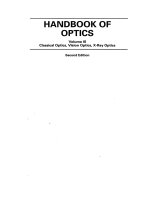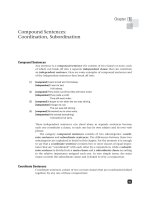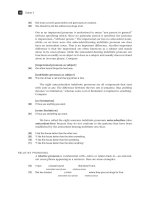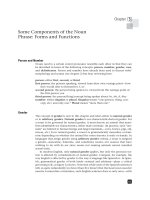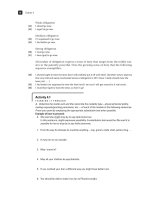Handbook of hpt third edition
Bạn đang xem bản rút gọn của tài liệu. Xem và tải ngay bản đầy đủ của tài liệu tại đây (4.73 MB, 1,410 trang )
S
S
Handbook of Human
Performance Technology
Third Edition
Principles, Practices, and Potential
James A. Pershing
Editor
Foreword by Harold D. Stolovitch and Erica J. Keeps
Praise for the Handbook of Human
Performance Technology, Third Edition
“This third edition of the seminal Handbook weaves in two decades of applied
HPT experience to provide even more relevant guidelines to today’s performance
improvement practitioners as they continue the important work of leveraging
an organization’s most precious capital—its people—toward verifiable, measurable, and valuable outcomes.”
—Clare Marsch, senior principal, global learning consulting,
Convergys Learning Solutions
“The Handbook of Human Performance Technology is a valued resource for professionals who lead learning and performance improvement efforts in organizations. In this edition, top thinkers in our field take on the tough issues,
summarize current thinking, and offer valuable new insights.”
—Catherine M. Sleezer, CPT, Ph.D., professor, human
resource/adult education, Oklahoma State University
“This Handbook not only bridges the gap between European and American performance improvement strategies, it also includes key multicultural approaches
for change agents that focus on business results.”
—Steven J. Kelly, CPT, managing partner, KNO Worldwide
“Taking the helm with the third edition, James Pershing ensures that the Handbook of Human Performance Technology retains its leading role in the field. Two
aspects particularly resonate: a new classification of interventions at the worker
and team levels and workplace and organizational levels, and a superb section
on measurement and assessment, which concisely applies a variety of research
and evaluation techniques specifically for use in our field.”
—Saul Carliner, assistant professor, graduate program in educational
technology, Concordia University, Montreal, Canada
“The Handbook’s clear and supportive structure and the high scientific and/or
practical expertise of its authors makes this excellent documentation of HPT’s
mission, values, processes, and tools very beneficial and credible for both managers and HPT practitioners in work or social settings as well as academic readers with interest in state-of-the-art HPT related knowledge and experience.”
—Verena Dziobaka-Spitzhorn, house of training/
head of learning and communication, METRO Cash &
Carry International GmbH, Germany
“The Handbook reflects the vast and diverse experience of the very best thinking and applications of HPT in the world today. It is an invaluable and comprehensive reference for anyone interested in improving human performance in
the workplace.”
—Christine Marsh, CPT, principal, Prime Objectives,
United Kingdom
“As the knowledge revolution takes hold, victory will go to the smartest organizations and societies. This must-have reference handbook provides consultants and business leaders with visual models, practices, and case histories to
achieve measurable improvements in human performance and business results.”
—Geoffrey A. Amyot, CPT, CEO, Achievement
Awards Group, South Africa
S
S
Handbook of Human
Performance Technology
Third Edition
Principles, Practices, and Potential
James A. Pershing
Editor
Foreword by Harold D. Stolovitch and Erica J. Keeps
Copyright © 2006 by John Wiley & Sons, Inc.
Published by Pfeiffer
An Imprint of Wiley
989 Market Street, San Francisco, CA 94103-1741
www.pfeiffer.com
No part of this publication may be reproduced, stored in a retrieval system, or transmitted in any form or by
any means, electronic, mechanical, photocopying, recording, scanning, or otherwise, except as permitted under
Section 107 or 108 of the 1976 United States Copyright Act, without either the prior written permission of the
Publisher, or authorization through payment of the appropriate per-copy fee to the Copyright Clearance Center,
Inc., 222 Rosewood Drive, Danvers, MA 01923, 978-750-8400, fax 978-646-8600, or on the web at www.
copyright.com. Requests to the Publisher for permission should be addressed to the Permissions Department,
John Wiley & Sons, Inc., 111 River Street, Hoboken, NJ 07030, 201-748-6011, fax 201-748-6008, or online at
/>Limit of Liability/Disclaimer of Warranty: While the publisher and author have used their best efforts in
preparing this book, they make no representations or warranties with respect to the accuracy or completeness
of the contents of this book and specifically disclaim any implied warranties of merchantability or fitness for a
particular purpose. No warranty may be created or extended by sales representatives or written sales materials.
The advice and strategies contained herein may not be suitable for your situation. You should consult with a
professional where appropriate. Neither the publisher nor author shall be liable for any loss of profit or any
other commercial damages, including but not limited to special, incidental, consequential, or other damages.
Readers should be aware that Internet websites offered as citations and/or sources for further information may
have changed or disappeared between the time this was written and when it is read.
For additional copies/bulk purchases of this book in the U.S. please contact 800-274-4434.
Pfeiffer books and products are available through most bookstores. To contact Pfeiffer directly call our
Customer Care Department within the U.S. at 800-274-4434, outside the U.S. at 317-572-3985,
fax 317-572-4002, or visit www.pfeiffer.com.
Pfeiffer also publishes its books in a variety of electronic formats. Some content that appears in print may not
be available in electronic books.
Copyright page continued on 1,364.
Cataloging-in-Publication Data on file with the Library of Congress.
Acquiring Editor: Matthew Davis
Director of Development: Kathleen Dolan Davies
Production Editor: Nina Kreiden and Liah Rose
Editor: David Horne
Manufacturing Supervisor: Becky Carreño
Editorial Assistant: Leota Higgins
Illustrations: Interactive Composition
Corporation
Printed in the United States of America
Printing 10 9 8 7 6 5 4 3 2 1
S
S
To Patricia Lorena, James Frederick, and Dara Lynn
S
S
S
CONTENTS
Foreword to the Third Edition xiii
Harold D. Stolovitch, Erica J. Keeps
Preface xxi
Acknowledgments xxvii
The Editor and Editorial Advisory Board xxix
Foreword to the First Edition xxxi
Thomas F. Gilbert
Foreword to the Second Edition xxxvii
Robert F. Mager
PART ONE: FOUNDATIONS OF HUMAN PERFORMANCE TECHNOLOGY 1
Monique Mueller, editor
1 Human Performance Technology Fundamentals 5
James A. Pershing
2 The Performance Architect’s Essential Guide to the Performance
Technology Landscape 35
Roger M. Addison, Carol Haig
3 Business Perspectives for Performance Technologists 55
Kenneth H. Silber, Lynn Kearny
vii
viii CONTENTS
4 Performance Improvement: Enabling Commitment to Changing
Performance Requirements 93
William R. Daniels, Timm J. Esque
5 Systemic Issues 111
Dale M. Brethower
6 Mega Planning and Thinking: Defining and Achieving
Measurable Success 138
Roger Kaufman
7 The Origins and Evolution of Human Performance Technology 155
Camille Ferond
PART TWO: THE PERFORMANCE TECHNOLOGY PROCESS 189
Jim Hill, editor
8 Aligning Human Performance Technology Decisions with
an Organization’s Strategic Direction 191
Ryan Watkins
9 Analysis and More 208
Allison Rossett
10 Requirements: The Bridge Between Analysis and Design 223
Ray Svenson
11 Modeling Mastery Performance and Systematically Deriving the
Enablers for Performance Improvement 238
Guy W. Wallace
12 Dimensions of Organizational Change 262
Larissa V. Malopinsky, Gihan Osman
13 Using Evaluation to Measure and Improve the Effectiveness of Human
Performance Technology Initiatives 287
Robert O. Brinkerhoff
14 The Full Scoop on Full-Scope Evaluation 312
Joan C. Dessinger, James L. Moseley
PART THREE: INTERVENTIONS AT THE WORKER AND WORK TEAM LEVELS 331
Karen L. Medsker, editor
15 Instruction as an Intervention 335
Michael Molenda, James D. Russell
CONTENTS
16 Designing Instructional Strategies: A Cognitive Perspective 370
Kenneth H. Silber, Wellesley R. Foshay
17 Games and Simulations for Training: From Group Activities
to Virtual Reality 414
Robert L. Appelman, John H. Wilson
18 Distance Training 437
José Manuel Ochoa-Alcántar, Christy M. Borders, Barbara A. Bichelmeyer
19 Innovations in Performance Improvement with Mentoring 455
Margo Murray
20 Motivating Individuals, Teams, and Organizations 478
Richard E. Clark
21 Shifting Organizational Alignment from Behavior to Values 498
Anthony W. Marker
22 Principles and Practices of Work-Group Performance 516
Michael F. Cassidy, Megan M. Cassidy
23 Performance Support Systems 539
Steven W. Villachica, Deborah L. Stone, John Endicott
PART FOUR: INTERVENTIONS AT THE WORKPLACE
AND ORGANIZATIONAL LEVELS 567
Mark J. Lauer, editor
24 The Impact of Organizational Development 571
Brian Desautels
25 The Fifth Discipline: A Systems Learning Model for Building
High-Performing Learning Organizations 592
M. Jeanne Girard, Joseph Lapides, Charles M. Roe
26 Knowledge Management, Organizational Performance,
and Human Performance Technology 619
Debra Haney
27 Coming to Terms with Communities of Practice: A Definition
and Operational Criteria 640
Sasha Barab, Scott J. Warren, Rodrigo del Valle, Fang Fang
28 Workplace Design 665
Karen L. Medsker
ix
x CONTENTS
29 Six Sigma: Increasing Human Performance Technology
Value and Results 692
Darlene M. Van Tiem, Joan C. Dessinger, James L. Moseley
30 Normal Excellence: Lean Human Performance Technology
and the Toyota Production System 717
Joachim Knuf, Mark J. Lauer
PART FIVE: PERFORMANCE MEASUREMENT AND ASSESSMENT 743
Jana L. Pershing, editor
31 A Commentary on Quantitative and Qualitative Methods: Myths
and Realities 745
Jana L. Pershing
32 Constructing Effective Questionnaires 760
Sung Heum Lee
33 Interviewing to Analyze and Evaluate Human Performance
Technology 780
Jana L. Pershing
34 Observation Methods for Human Performance Technology 795
James A. Pershing, Scott J. Warren, Daniel T. Rowe
35 Using Content Analysis in Human Performance Technology 819
Erika R. Gilmore
36 Quantitative Data Analyses 837
Mary Norris Thomas
37 Evidence-Based Practice and Professionalization of Human
Performance Technology 873
Ruth Colvin Clark
PART SIX: PERFORMANCE TECHNOLOGY IN ACTION 899
Debra Haney, editor
38 Making the Transition from a Learning to a Performance Function 903
Dana Gaines Robinson, James C. Robinson
39 Using an HPT Model to Become Management’s Partner 924
Danny Langdon
40 Managing Human Performance Technology Projects 943
Nicholas Andreadis
CONTENTS
41 Leadership in Performance Consulting 964
Roger Chevalier
42 The Anatomy of Performance: A Framework for Consultants 986
Geary A. Rummler
43 Certification: An Alignment Intervention 1008
Judith A. Hale
44 Standards and Ethics in Human Performance Technology 1024
Ingrid J. Guerra
45 Professional Ethics: A Matter of Duty 1047
Jim Hill
46 Improving Human Performance by Employing a Top-Down Function
Analysis Methodology in Navy Aircraft Design 1067
Dennis Duke, Robert Guptill, Mark Hemenway, Wilbur Doddridge
PART SEVEN: LOOKING FORWARD IN HUMAN PERFORMANCE TECHNOLOGY 1085
Darlene M. Van Tiem, editor
47 SWOT Analysis 1089
Doug Leigh
48 Sustainable Development and Human Performance Technology 1109
Scott P. Schaffer, Therese M. Schmidt
49 Rapid Reflection Throughout the Performance-Improvement
Process 1122
Sharon J. Korth, Brenda S. Levya-Gardner
50 Appreciative Inquiry: Unraveling the Mystery of Accentuating
the Positive 1147
Darlene M. Van Tiem, Julie Lewis
51 Comprehensive Performance Evaluation: Using Logic Models to
Develop a Theory-Based Approach for Evaluation of Human
Performance Technology Interventions 1165
Barbara A. Bichelmeyer, Brian S. Horvitz
52 Aligning the Human Performance System 1190
John Amarant, Donald T. Tosti
53 Systems, Measures, and Workers: Producing and Obscuring the
System and Making Systemic Performance Improvement Difficult 1224
Donald J. Winiecki
xi
xii CONTENTS
54 Hidden Order of Human Performance Technology:
Chaos and Complexity 1251
Darlene M. Van Tiem, Swati Karve, Jennifer Rosenzweig
55 Quantulumcunque Concerning the Future Development
of Performance Technology 1274
Klaus D. Wittkuhn
About the Editor 1286
About the Contributors 1288
The International Society for Performance Improvement 1311
Name Index 1312
Subject Index 1326
Addendum to the Copyright Page 1364
S
S
FOREWORD TO
THE THIRD EDITION
uman performance technology (HPT) is a professional field of study and
application, the main purpose of which is to engineer systems that allow
people and organizations to perform in ways that they and all stakeholders value. HPT is a derivative field that for over a half of a century has evolved
from a number of disciplines, such as psychology, communications, neuroscience, management science, information science, economics, ergonomics, and
measurement and evaluation. It is also the progeny of a number of applied
fields, such as instructional technology, human resource development, organizational development, and industrial engineering.
Eclectic as this all sounds, HPT has grown to become a distinct specialty with
its own international, national, and local professional societies as well as
numerous publications, university programs, and certification structures that
lend it credence. It has emerged as a domain of practice that is increasingly relevant, if not essential, for today’s organizational success. The term human performance technology sounds somewhat dry and mechanistic. Hence, human
performance improvement (HPI) has begun to appear in professional publications as a more acceptable euphemism. We view HPT as the rigorous means for
achieving valued performance, that is, what we as performance-improvement
specialists do, and HPI as the end result, that is, what we accomplish. Regardless of the terminology, HPT-HPI has come to represent a unique area of study,
research, and professional practice, one that is worthy of recognition in the
world of work and, more recently, in nonwork and social settings.
H
xiii
xiv FOREWORD TO THE THIRD EDITION
THE HANDBOOK OF HUMAN PERFORMANCE TECHNOLOGY:
A FOUNDATION DOCUMENT
Such an energetic field must, at points in its development, stop for a moment
to consolidate its thinking, values, position, mission, direction, and practices
and make a statement about what it is and why anyone should care. This statement serves three purposes: (1) to help its diverse scholars and practitioners
disengage themselves from their daily, disparate, and pressing activities and
reflect on who they really are as a family; (2) to inform the outside world of
what the field is all about and why its existence is so excitingly important; and
(3) to guide those entering the field and those responsible for informing new
members on what and where to focus.
The statement HPT has made is this Handbook of Human Performance Technology. In 1988, the then National Society for Performance and Instruction (NSPI),
now the International Society for Performance Improvement (ISPI), realized that
while it was preaching HPT vigorously and vociferously, the message was not
coming through very clearly. A stronger affirmation had to be made. A source document was necessary to inform the world of what HPT was all about. The result
was the launching of a publication initiative. We were selected to be the parents of
this publication, and our job was to give birth to a powerful HPT manifesto.
Here was our mission as it appeared in 1992 in the preface to the first edition
of the handbook:
What has been needed as a solid cornerstone for the field . . . is a major
publication that clearly articulates, to the world and to HPT professionals, that
we have arrived. That is the purpose of the Handbook of Human Performance
Technology: to announce the existence of an emerging, highly relevant field, and
to express what this field is about, where it comes from, what it does, and how
its principles and practices can very significantly benefit organizations that seek
outstanding results [Stolovitch and Keeps, 1992, p. xx].
Little did we realize what an undertaking this was to be, involving almost three
years of intense work. Also, little did we anticipate its impact. Not only were
the handbook’s sales outstanding, it soon became the major textbook for university programs that were adding ever-increasing numbers of professionals to
the field. The first edition also generated widespread, international enthusiasm
for HPT. This resulted in a second edition, this time with a global thrust. What
came out of this two-and-a-half-year effort was a markedly increased worldwide
profile for HPT and many new adherents to the field from a host of nations.
However, as optimistic as we were about the staying power of the handbook,
we certainly could not have predicted an entirely new, amazingly updated third
edition some fourteen years after the first one. We view the contents of this
FOREWORD TO THE THIRD EDITION
outstanding, highly evolved volume with awe and admiration for what Professor Pershing and his authors have accomplished and strong emotion at seeing
how far the field has evolved in so short a time.
HPT: HOW FAR WE HAVE COME
Speaking about our advances as a professional group, it is tremendously impressive to note the indicators of our dramatic growth. Witness the numerous books,
chapters, periodicals, and articles dealing with HPT themes. Since 1992, publications have multiplied tenfold. The number of university programs and courses
focused on human performance at work has burgeoned, and not only in the United
States and Canada where the movement began, but also in Europe, the Middle
East, Africa, South America, Australia, New Zealand, and throughout the world
where there are people searching for ways to achieve organizational results valued by all. As an example, over the past year, we ourselves received requests for
HPT guidance, suggested readings, and learning opportunities from countries
including China, Mongolia, Uzbekistan, Malaysia, Singapore, Bangladesh,
Romania, South Africa, Colombia, Israel, and Niger. In this listing, we do not even
name the Western European countries, as they have now become normal fare,
something we would not have said even ten years ago.
Along with the impact on publications and programs are the noticeable changes
to professional societies and organizations that once were centered exclusively on
training. The American Society for Training and Development, now ASTD, and
VNU, publishers of Training, have begun to include the term performance in their
taglines, including those for their various certificate programs. Recently a new
magazine, Workforce Performance Solutions, sprang into existence, an offshoot of
the Chief Learning Officer magazine. Also, let us not forget the emergence of the
HPT certification program from the flagship organization for HPT, ISPI. The ISPI
Certified Performance Technologist (CPT) program now has produced over one
thousand CPTs worldwide. In contributing to growing the field, ISPI has also
designed and developed a comprehensive set of professional development institutes for individuals and organizations interested in integrating HPT. Several large
companies and organizations now have performance-improvement units. Prominent among these is the United States Navy Human Performance Center.
THE RELEVANCE OF HPT
While HPT has dramatically evolved since the first edition of the handbook, it is
not one of those flash-in-the-pan fads that explodes on the organizational scene
with blinding éclat, only to dissolve into forgotten history like a celebrity diet.
Here is why HPT has stood and will continue to stand the test of time.
xv
xvi FOREWORD TO THE THIRD EDITION
• A concern with bottom-line results and return-on-investment (ROI) issues.
Yes, HPT possesses strong processes. Nevertheless, its central focus, as one of
HPT’s major founders, Thomas F. Gilbert, often stated, is valued accomplishment, meaning verifiable results that far exceed their costs. The ferociously competitive global marketplace drives organizations. In a world of limited resources,
for-profit, nonprofit, and social welfare organizations all find themselves competing for these as well as scarce funds. Anything that can deliver high ROI and
positive cost-benefit ratios as well as demonstrate impact supported by data
immediately draws attention. This is HPT’s raison d’être. HPT is bottom line
and measurement conscious, imbuing it with ongoing relevance.
• The high stakes of high investment. As technology and communications innovations generally cause major changes to organizations, virtually any significant
initiative demands the investment of large sums to ensure successful adoption. A
new way of tracking customer buying behaviors can quickly mount into the millions of whatever currency one is using. Will the employees adapt well to it? Will
the full potential of its promise be realized? These are the concerns of the enterprise. These are also the key issues with which HPT professionals deal.
• The increased emphasis on measurement: Six Sigma and its relatives. Long
before Six Sigma, reengineering, and even total quality management appeared on
the scene, there was HPT using a language very similar to all of these movements.
HPT has always emphasized systemic analysis, systematic processes, holistic intervention design, and measurement. From time to time, individual practitioners
may have been swayed by enthusiasms and fads, but not so for the field itself.
HPT is about demonstrated hardcore results. If HPT could have a motto, it might
very well be, “let data talk.” Its caution would be, “beware enthusiasms!”
• Systems thinking. HPT is an applied offspring of general systems theory.
Unlike science, which focuses on ever more minute phenomena viewed through
the lens of a microscope, HPT employs a macroscope (de Rosnay, 1975) to
examine all of the relevant elements that interact to affect the activities and outcomes of a system. Human performance is, as Gilbert (1996) suggested, valued
accomplishment derived from costly behavior. To achieve valued accomplishment means analyzing all of the costly behavior elements and designing an integrated set of interventions that most efficiently generates desired and measured
results. In our complex current and most likely future world, HPT possesses the
appropriate viewpoint, processes, and validated tools to achieve constantly
accelerating organizational goals.
• Changes to departmental titles. In the same way that personnel morphed
into human resources and accounting into finance, training is in a period of
transition to a new and more strategic state. The first transformational baby steps
have been to learning, learning services, or learning and development. The bolder
organizations have changed to workforce development, workplace learning and
FOREWORD TO THE THIRD EDITION
performance, learning and performance support, and even performance enhancement. What is in a name? Opinions abound. Nevertheless, changes in labels
when accompanied by modifications and additions in activities, services, and
deliverables certainly alter expectations and outcomes. The newer departmental
or service titles appear to match more closely the needs of organizations. As such
these augur well for evolved, more strategic, systemic roles than tactical training
ever provided.
• The interrelationship of HPT with human resource development (HRD),
organizational effectiveness (OE), and organizational development (OD). What
we have asserted to date about HPT is in many ways true of other related fields.
Gilley, Maycunich, and Quatro (2002) forcefully pointed out that the role of HRD
professionals has been mainly a transactional one just as in the case of training. They encourage greater focus on becoming more transformational and performance focused. As they assert, “the challenges facing organizations require
HRD professionals to adopt a role that improves firm performance, enhances
competitive readiness, and drives renewal capacity and capability” (p. 25).
From the field of OE, we witness a growing emphasis on helping the organization fulfill its mission through a blend of sound management, strong governance, and a persistent redirection to achieving results. The concerns of OE
sound markedly familiar to HPT professionals.
What is true for HRD and OE can also be repeated for OD. While OD generally operates at macro levels of organizations, its mission is that of increasing
organizational effectiveness and health through planned interventions in the organization’s processes or operations. OD may not adopt the engineering style of
HPT; it is more characterized by its emphasis on communication and facilitation.
However, its purpose, as with HPT, is to deliver valued organizational results,
largely through people. This is not a far cry from HPT’s concern with improving
human performance.
These convergences, although seemingly threatening to the exclusivity of HPT’s
terrain, in fact only enhance its relevance. All desire valued performance. Each has
its approach. HPT’s is that of engineer. In this respect, it is well positioned for creating solid business cases for its activities and presenting data-based evidence of
desirable outcomes. Increasingly, organizational decision makers demand this.
THE EMERGENCE OF HUMAN CAPITAL
Perhaps we should speak more of human capital’s reemergence. Theodore
Schultz, in 1979, and Gary Becker, in 1992, both won Nobel prizes in economics for their work in human capital. There was a brief period of excitement for
xvii
xviii FOREWORD TO THE THIRD EDITION
this then-new concept in the early 1980s that quickly faded. However, in the last
seven or eight years, the human capital theme has once again emerged as a serious and strategic business issue. A number of authors such as Davenport (1999),
Edvinsson and Malone (1997), Fitz-enz (2000), Kravetz (2004), Pfeffer (1998),
and Stewart (1997) have fanned the flames of human capital accounting and
potential and have demonstrated the high returns to be derived from human capital management. By human capital, we mean the sum total of all knowledge,
experience, and performance capability an organization possesses that can be
applied to create wealth. The key words are performance capability. This is HPT’s
purview, and in this respect, the HPT professional, as portrayed throughout the
chapters of this handbook, is above all a leverager of human capital. In fact, one
might sum up the essential elements of this third edition of the Handbook of
Human Performance Technology in the following ways:
• The key mission of HPT: the leveraging of human capital in the most
efficient manner to achieve targeted, valued results.
• The key process of HPT: the engineering of valued and effective individual and organizational performance based on systemic, systematic, and
scientific principles and demonstrated through credible measures.
• The key roles of the HPT professional: analyst, consultant, designer,
evaluator, facilitator, project manager, management mentor, and, as
required, organizational therapist.
• The key contexts of HPT application: the workplace or work setting.
However, increasingly, HPT is being applied in social settings, for
example, reproductive health in developing nations, community
substance abuse programs, public education, and improved quality
of life for the chronically ill and aged.
AND SO THIS THIRD EDITION OF THE HANDBOOK OF HUMAN
PERFORMANCE TECHNOLOGY . . .
As you enter the pages of this remarkably impressive volume, you will be struck
with how firmly the handbook still remains a foundation document. Now that
it is in its third iteration, it has also assumed two new and extremely important
roles: that of chronicler of HPT’s progress as an evolving field and that of credible witness to HPT’s ongoing relevance to organizations, workers at every level
and of all stripes, and society at large. As was meant to be, it fulfills the role
of authoritative guide and standard bearer for HPT’s mission, processes, values,
and practices.
FOREWORD TO THE THIRD EDITION
Having twice stood in the shoes of editor James Pershing, we can appreciate
the many months of tireless effort that he, the editors, and all of the contributors have invested to bring forth this important milestone that is the new handbook. It marks a significant moment in the history of HPT. It also represents a
challenge for even greater HPT achievements in the years ahead.
February 2006
Harold D. Stolovitch
Erica J. Keeps
Los Angeles, California
References
Davenport, T. B. (1999). Human capital: What it is and why people invest in it.
San Francisco: Jossey-Bass.
de Rosnay, J. (1975). Le macroscope, vers une vision globale. Paris: Le Seuil.
Edvinsson, L., and Malone, M. S. (1997). Intellectual capital: Realizing your company’s
true value by finding its hidden brainpower. New York: HarperCollins.
Fitz-enz, J. (2000). The ROI of human capital: Measuring the economic value of
employee performance. New York: American Management Association.
Gilbert, T. F. (1996). Human competence: Engineering worthy performance.
Washington, DC: International Society for Performance Improvement.
Gilley, J. W., Maycunich, A., and Quatro, S. A. (2002). Comparing the roles responsibilities, and activities of transactional and transformational HRD professionals.
Performance Improvement Quarterly, 15(4), 23–44.
Kravetz, D. J. (2004). Measuring human capital: Converting workplace behavior into
dollars. Mesa, AZ: Kravetz Associates.
Pfeffer, J. (1998). The human equation: Building profits by putting people first. Boston:
Harvard Business School Press.
Stewart, T. A. (1997). Intellectual capital: The new wealth of nations. New York:
Doubleday/Currency.
Stolovitch, H. D., and Keeps, E. J. (Eds.). (1992). Handbook of human performance
technology: A comprehensive guide for analyzing and solving performance problems
in organization. San Francisco: Jossey-Bass.
xix
S
S
PREFACE
t is true; the one constant we can count on in this modern world is change.
Since 1992, when Harold D. Stolovitch and Erica J. Keeps so ably coedited
the first edition of the Handbook of Human Performance Technology, the world
in which we live and work has undergone significant transformation. Several
of these changes and their impact were captured in Stolovitch and Keeps’s second edition of the handbook, published in 1999. However, when one compares
and contrasts the first two editions of the handbook, one will note that there
are constants in the forms of truisms and principles in the field of human performance technology (HPT) that transcend time. Our goal in producing this third
edition of the handbook, some six-plus years after the second edition, was
twofold: to capture the truisms and principles of HPT and to address what we
judge to be some important transformations.
We purposefully established seven objectives to achieve these two purposes.
In 2004 we worked with trusted formal and informal leaders in HPT, seeking
their advice and counsel in setting the direction and content for the handbook.
At HPT conferences and meetings we spoke in person with a number of individuals we judged to be established leaders in HPT. We sought their input and
asked them to suggest others to contact. This led to our contacting a total of
fifty individuals from whom we received valued advice in person, by e-mail, or
over the telephone. Their input helped us to develop further objectives as well
as to identify authors and to select members for the handbook editorial advisory
board.
I
xxi
xxii PREFACE
Given the interlude between the first two editions of the handbook and this
third edition, the second objective was to have all new chapters. This objective
has been met with fifty-five new information-rich chapters for this third edition.
A third objective was to have well-recognized leaders and subject-matter
experts in HPT author at least one-half of the chapters. The reason for this
objective was to give the handbook credibility and marketability. As a leading
contributor to the field of HPT, the handbook must contain the ideas and views
of our thought-and-practice leaders. Each of you may count differently; however, in our judgment, thirty of the fifty-five chapters have one or more authors
that meet this criterion. The remaining chapter authors are emerging leaders in
HPT or thought-and-practice leaders from fields closely aligned with HPT.
As a fourth objective, we sought diversity among the chapter authors, in
terms of (1) demographics such as gender, years of experience in HPT, and
nationality; (2) position, including academics, consultants, practicing professionals in business and the public sectors, and expertise representing a broad
range of HPT interventions; and (3) what some affectionately dub old, new, and
no guards in terms of perceived roles in the field of HPT and our flagship organization, the International Society for Performance Improvement. These judgments too will be in the eyes of the beholder. In our judgment we achieved our
diversity objective.
Objective five had to do with a personal bias of mine, which stems from my
years of experience in academia. I believe that knowledge is best advanced
when it combines theory and practice and when we recognize that worthwhile
ideas and views evolve from the in-depth study of and appreciation for the work
of those who preceded us as well as from our contemporaries. In short, there
are no giant leaps in knowledge development or practice in disciplines and fields
of study associated with the social sciences. There are incremental steps, often
forward, but sometimes backward, that come from synthesizing, integrating,
and trying out the ideas or practices of others in different settings or ways. To
this end, we were insistent that all chapter authors overtly acknowledge the
impact of others on their work by citing and referencing the pertinent research,
theoretical, and professional practice literature generously and accurately.
Our sixth objective also reflects a professional bias I have about the field of
HPT. It is generally recognized that many of the principles and practices of HPT
evolved from the field of instructional technology (IT). Over time, many performance technologists have expanded both the principles and practices of HPT,
embracing ideas and views from a number of other academic and professional
practice fields. However, the pervasiveness of education and training in HPT is
substantial in my judgment. This dominance of IT in HPT exists in part for two
important reasons. First, many practicing performance technologists and students of HPT have as their primary professional homes institutionalized
PREFACE
programs that have education or training as a first line of business. There are
not large numbers of organizations or academic programs with HPT as the single or even dominant focus. Second, education and training, especially when
broadly viewed, are more often than not a part of the intervention set that performance technologists often settle upon to address performance issues. This is
particularly true when one looks at primary or first-level interventions versus
secondary or second-level interventions. Even if training is not a primary intervention, it often comes into play as other interventions are implemented. For
example, retooling may be a logical choice to solve quality problems with a
manufacturing process. However, the personnel responsible for implementing
and using the new tooling may need formal or informal training or job aids to
be effective. Whether this pervasiveness of education and training in HPT is real
or perceived, I believe that it has existed for too long and has in part retarded
the development and use of non-education interventions. Perhaps this is epitomized best by the number of HPT models and publications about HPT practice,
including the first two editions of this handbook, that categorize or classify
interventions as being of an instructional versus noninstructional nature. For
this third edition of the handbook, we have chosen to address this issue by having parts of the book dealing with interventions designated as “Interventions at
the Worker and Work Team Levels” and “Interventions at the Workplace and
Organizational Levels.” Four of the sixteen chapters in these two parts deal with
some aspect of education and training. The others deal with a wide array of
other interventions.
Finally, we had as our seventh objective the development of a brand new part
for the handbook. For the first time, the handbook addresses issues related to
a core practice of HPT, the gathering and analysis of data, and its transformation to information for use by performance technologists and their clients. We
have a number of chapters devoted to performance measurement and assessment. We hope this added dimension is valued by our readers and contributes
to improving the practice of HPT.
INTENDED AUDIENCES
As with the first two editions of the handbook, we believe that this third edition will appeal to a broad array of readers and users. We anticipate that human
performance technology practitioners will use the handbook as their primary
reference tool. We also believe that students and faculty in academic programs
and those in professional development programs will use it as a textbook.
We anticipate that the ways we have treated and presented interventions will
have greater appeal to a number of individuals and groups that are interested
xxiii

